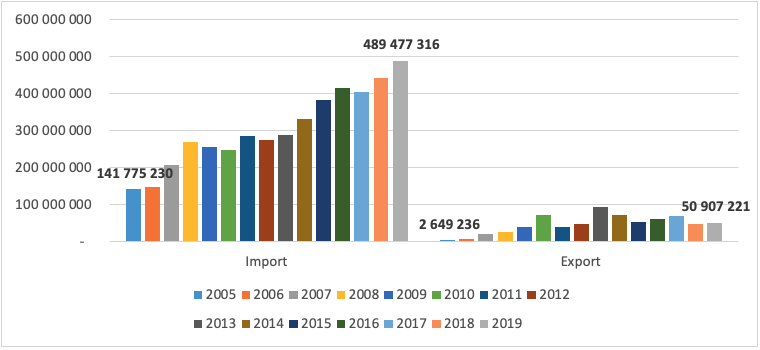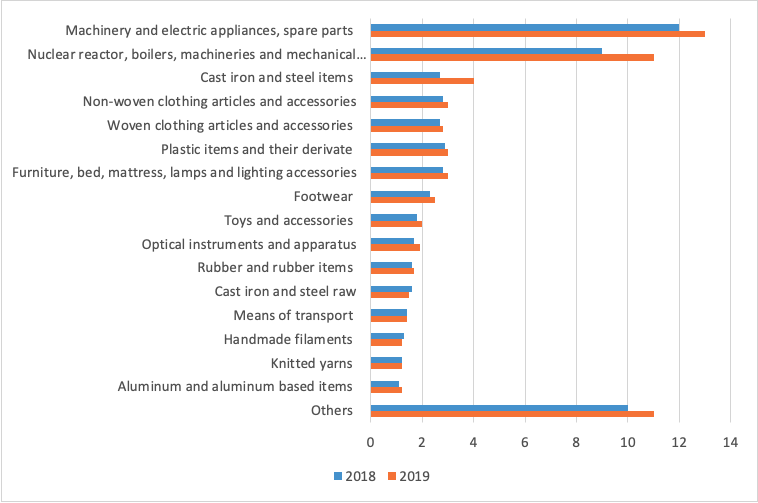Weekly Briefing, Vol. 26, No. 2 (Al), February 2020
China officially Albania’s third trading partner
Introduction
For decades Albania depends on imports for most of its internal consumption and according to the latest World Bank releases, the country’s trade in merchandise represents 58.3% of its Gross Domestic Product (GDP). As official sectorial data are made public, one dataset attracted attention in almost all economic analysis outlets in February 2020 –Made in China commodities have a sharp increase in Albania’s market. Chinese based products are present in Albania significantly after 2001, which coincides with China’s accession into the World Trade Organization (WTO); in the first years of the millennium imports from PRC were not abundant, however, this trend changed after the financial crisis of 2008 – since that year on imports from PRC went increasing and by making it 5th, 4th and as of recently a steady 3rd trading partner.
Overview of main import partners in years
Since the very beginning of Albania’s economic opening up to the world trade, the most “natural” trading partners become neighboring countries such as Italy, Greece, and Turkey; later on, Germany and China joined the top five priority associates in trade. The above mentioned has been switching positions in years (going from second to third or fourth, or vice versa) with the sole exception of Italy. Italy has always been the most important trading partner of Albania due to a variety of reasons: territorial proximity initially, improving logistics year by year and last but not least a vast community of Albanian nationals living in Italy with intense and tight connections to their motherland – they influenced trends, market orientation, prices, and sales. Albania is the 126th largest export economy in the world and the 92nd most complex economy according to the Economic Complexity Index (ECI).[i] According to the same database, top exports of Albania are Leather Footwear, Footwear Parts, Chromium Ore, Ferroalloys and Crude Petroleum using the latest revision of the HS (Harmonized System) classification; while its top imports are Cars, Refined Petroleum, Packaged Medicaments, Tanned Equine, and Bovine Hides, and Footwear Parts.
In 2019, trade with the EU countries occupied 68.1 % of the total. Exports to EU countries accounted for 76.6% of total exports and imports from EU countries accounted for 63.9% of total imports. In order of percentage out of a total, the classification for yearly trade volume was: Italy 34.4%, Greece 7.5%, China 7.4%, and Turkey 7.2%. Always as of latest releases, the highest growth in comparison to the previous year were Turkey + 14%, China + 11% and Greece (+4.3%); while the countries with which imports had the most decrease the largest are Italy -6.3%, Germany -6.2% and Russia -8.2%.
In order to have a better understanding of how imports by country have been flowing in Albania the table below indicates the input in value for the last 15 years. It can be observed that it is only Turkey and China that have ever-increasing value on a yearly bases.
Fig 1- Imports in Albania according to Country of Origin (Unit: Euro)

Source: INSTAT database (own graphic elaboration/average exchange rate 1 Euro = 122 Lek)
Chinese commodities on the rise
Trade (and investments) between China and Albania has been the focus of some important ad hoc, intergovernmental commissions. In a tentative to revive cooperation, China-Albania Joint Intergovernmental Economic and Trade Commission was set up in 1989 and is an important body of exchanges for economic and trade cooperation between the two sides. [ii] From that year on there have been nine high-level meetings focused on economic exchange, with the latest held in Ningbo in 2018 under the 9th Session of the Joint Economic Commission between Albania and China (with the 8th session being held in 2014 in Tirana). In the occasion, the Albanian Deputy Minister of Finance and Economy, Albana Shkurta and the Chinese Deputy Minister of Commerce Fu Ziying led the joint meeting and stated that it has become an important opportunity to consolidate the results of the cooperation and to expand the potential of cooperation. Through this meeting, concrete cooperation will be fostered in important areas including the processing industry, agricultural products, and cooperation in the tourism sector. At the same time, efforts will be made to boost cooperation in the infrastructure sector to consolidate uninterrupted economic and trade relations between the two countries and to realize mutual interests and benefits. Parties finalized that, both sides are paying attention to increased cooperation in the infrastructure sector in order to further consolidate trade and economic relations.[iii]
However, many Albanian entrepreneurs claim that government support has not been at the forefront when dealing with Chinese commodities in Albania. In fact, their argument is that the only driving force for them to establish a partnership with Chinese factories and purchase their goods is theirs (and their staff’s) efforts and endeavors into finding the best source possible for their purchases. Many Albanian companies, be this small, medium or large, have as their only point of connection with Chinese suppliers online business-to-business (B2B) platforms or trade fairs and exhibitions (Canton Fair for example). It is almost impossible to find a retailer or wholesaler of considerable size in Albania that does not import Chinese commodities, for this reason, and plenty of others, more should be done in order to support and incentivize these businesses in their quest for the best price and quality.
Bilateral trade figures in years
In order to have a better understanding of the trajectory of imports in yearly bases the table below indicates bilateral exchange between the two countries and the rise is indeed satisfactory, not only in imports from China but also in exports. In fact, in 15 years imports from China rose by less than fourfold, while exports to China have an almost twentyfold increase.
Fig. 2 – Albanian national data: imports/from and exports/to PRC (Unit: Euro)

Source: INSTAT database[iv] (own graphic elaboration/average exchange rate 1 Euro = 122 ALL)
As annual sectorial statistics are made public in the country, the National Institute for Statistics (INSTAT) stated that China accounted for a total of 6.9% of trade volume in 2019, expanding so with 0.7% if compared to a year earlier. Bilateral trade was dominated by imports which were 9.7 times higher than exports. In figures which amounted to ALL 59.7 billion (498.47 million Euros) with an increase of 11% compared a year prior. Imports from China have risen sharply over the past two years following a decline of 2.6% in 2017. Albanian exports to China totaled ALL 6.2 billion (50.9 million Euros) in 2019, with annual growth of only 1 percent, however, this a better figure than one year prior when Made in Albania exports to China declined by 26%. Albanian exports to China are dominated by Chrome. Indeed, exports of ores reached ALL 5.9 billion (48.2 million Euros), accounting for 95 percent of total exports to China. Even in the past year, chrome exports have been dominant in the commodities Albania sells to China.
Breakdown by category
According to INSTAT data, imports from China are dominated by electrical equipment, sanitary, machinery which make up about 40 % of the total worth over ALL 23 billion (188 million Euros). Iron and steel commodities constitute the third most imported group from China at ALL 4 billion (31.7 million Euros), up 70% from a year earlier. Clothing is the fourth and fifth most imported goods from China for the Albanian market worth ALL 5.2 billion (42.5 million Euros), up 17 %compared to a year prior.
China’s plastic parts were estimated at ALL 2.1 billion (17.18 million Euros) or an annual increase of about 13.4% by 2019 and Chinese furniture imports reached ALL 2.3 billion (18.81 million Euros) with an increase of over 8% compared to one year prior.
Significant weight on busy imports comprises also furniture, beds, mattresses, lamps and lighting equipment, etc. The table below demonstrates the trend in the past two years. It is clearly shown that almost every category of commodities has a sharp increase.
Fig 3 – Imported goods from China in Albania according to group category (Unit: Billions ALL)

Source: INSTAT, own graphic elaboration (Exchange 1 billion Lek = 8,188,233 Euros)
The trend of rising Chinese imports into the Albanian market was noticed at the release of data every trimester; some outlets pictured the situation as depending on low-living standards and cost-saving attitude, by driving so the population to demand low prices regardless of quality, thus purchasing Made in China rather than EU originated goods, which according to them is reflected in the galloping growth of Chinese imports.[v] However, these claims do not match the reality.
According to Bank of Albania (BoA), in terms of aggregate demand components, economic growth in the first, second and third quarter of 2019 was supported by domestic demand. More specifically, “Consumption by the Population” delivered the main impact, expanding by 2.9% in annual terms.[vi]
Conclusions
It is our final argument based on the above-analyzed data that the increase of Made in China commodities in the Albanian market is not a result of the low purchasing power of the country but is rather due to the diversification of Chinese products and increase of items per category. The increase of imports from PRC stands in value as well as in a wider range of assortments, meaning Albanian entrepreneurs are purchasing in China products that up to some time ago were purchased in the region.
This also means a raised competitiveness of Chinese commodities in quality and most of all in price, considering here that all European Union based products enter the market with zero added tariffs (only a EURO1 certificate is needed) while there are some considerable tariffs for non-EU products varying from 2-15%.
[i] Albania country profile. Available at: https://oec.world/en/profile/country/alb/
[ii] Joint Intergovernmental Commission on China-Albania’s economic cooperation meeting held in Ningbo. RTI. Available at: http://rti.rtsh.al/2018/06/07/the-9th-meeting-of-the-joint-intergovernmental-commission-on-china-albanias-economic-trade-cooperation-was-held-in-ningbo/
[iii] Albania, China Officials Discuss Areas of Trade and Investment Cooperation. Available at: https://invest-in-albania.org/albania-china-officials-discuss-areas-trade-investment-cooperation/
[iv] National Institute of Statistics. Foreign trade indicators. Available at: http://www.instat.gov.al/al/temat/tregtia-e-jashtme/tregtia-e-jashtme-e-mallrave/
[v] Trade with China is booming, with a 13.3% increase in imports in June. OraNews. Translated from: https://www.orane ws.tv/index.php/article/lulezon-tregtia-me-kinen-rritja-13-3-e-importeve-ne-qershor
[vi] Consumer expansion affected economic growth in the second quarter of the year. Translated from: https://ata.gov .al/2019 /10/02/zgjerimi-i-konsumit-ndikoi-rritjen-ekonomike-ne-tremujorin-e-dyte/
